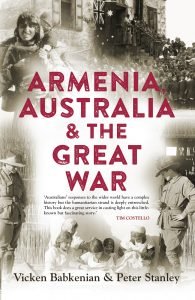Special for the Armenian Weekly
Armenia, Australia & the Great War
By Vicken Babkenian and Peter Stanley
University of New South Wales Press (September 1, 2016), 336 pages
ISBN-13: 978-1742233994; Paperback, $34.99

To date, works of scholarship have addressed numerous facets of the Armenian Genocide, from the systemic organization of the genocide begun by the Young Turks in 1915 to the subsequent plight of surviving Armenians.
In their recent book, independent researcher Vicken Babkenian and military historian Peter Stanley have addressed a topic scarcely covered: Australia’s relationship with the Armenians and the Armenian Genocide. To do so, the authors have used a wide variety of sources, including newspapers, eyewitness accounts, memoirs, and written testimonies.
Armenia, Australia & the Great War reveals both a historic and modern connection between Armenians and Australians by highlighting the role of the latter in Armenian history and the lives of Australian-Armenians. It covers the period of massacres leading to the Armenian Genocide of 1915 as well as Australian assistance provided to Armenians during the Great War and throughout the first half of the 20th century.
The authors attempt to provide a complete history by presenting instances of Armenian retaliation, the origins of Armenians in Australia, the treaties that addressed the Armenian question, and the Sovietization of Armenia. In doing so, the book branches outside of Australia’s military history during the Great War and the experience of the Anzacs and Australian Imperial Forces.
The authors delve into Australia’s role in the establishment of the modern humanitarian relief movement, which was sparked by the United States and Great Britain following WWI. Babkenian and Stanley document the experiences of notable Australian citizens—including James Cresswell, Edith Glenville, and Cecilia John—who witnessed the atrocities against the Armenian people and risked their lives to persistently fight for the survival of the victims.
Like the U.S. and Britain, Australia participated in relief efforts. The book places a spotlight on how Australians, specifically, aided the Armenians. The authors trace the work of notable Australian figures through their journey as witnesses to the Armenian Genocide, organizers of Australian relief organizations, and, eventually, founders of orphanages—across the Middle East—in which they worked.
A unique feature of the book is its treatment of the relationships between certain Armenians and Australians that developed during the latter’s military or humanitarian service. These sections underscore a deep, personal connection between the Armenian and Australian peoples. Dozens of Armenians who have contributed to or are otherwise intertwined with Australian history are mentioned—from Aram Okosdinossian, an Armenian interpreter in the Anzac army in 1915, to Haroutune Dilanian, a genocide survivor and ex-orphan from the Australasian Orphanage who eventually migrated to Australia in 1971.
The authors have successfully explained their position on the Armenian Genocide and the reasons they thought it necessary to do so in an Australian context. The overarching themes of the book are the migration of Armenians to Australia, Australian relief efforts following eyewitness accounts of the genocide, the current-day role of Australia in recognizing the Armenian Genocide, and the country’s close relationship with Turkey and the significant Turkish community that resides in Australia.
The text references the history and the relationship between Australia and Turkey, including the role of the Battle of Gallipoli in that relationship, but the authors stress that these events should be viewed through an unbiased lens. Babkenian explicitly states that although Australians might feel distressed by the subject of the book, they must nevertheless confront the reality of the genocidal crime committed against the Armenians by the Ottoman Turks.
The readability of this book is one of its greatest strengths. In the prologue, the authors explain that they intended for the book not to have an academic tone. The combination of exceptionally well-researched topic and lack of academic tone make for a smooth read that will appeal to wider audiences.
The book also features a dedicated section of images, providing firsthand evidence of the Armenian Genocide and helping readers understand that a plethora of documentation is available.
Despite the complicated subject matter, the educational yet easy-to-read style of Australia, Armenia & the Great War will certainly help ensure that this praiseworthy book reaches a broad audience.


The work is admirable in its thorough approach as well as its readability. I concur with this reviewer.
This brilliant book should be part of Australia’s education curriculum, Australia’s humanitarian efforts is as important as the ‘Anzac Legend’, what stood out for me whilst I read this groundbreaking book was that Armenians were unable to repay the kind Australians for their acts of humanity, it makes me extra appreciative of calling Australia home. There is a section of this fine book that writes about Ataturk, he asks the world governing authorities to return Turkish leaders who were sent to Malta to receive punishment for their war crimes, he gave assurances that he would administer justiice in Turkey; upon arrival ATATURK GAVE THEM POLITICAL POSTS!!!!!